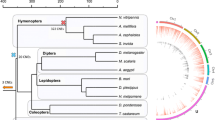Abstract
DNA sequences representing approximately 40% of the large-subunit rRNA gene from the lower dipteran Chironomus thummi were analyzed. Once aligned with their Drosophila counterparts, sequence and base content comparisons were carried out. Sequence identity was found to be high overall, except for six regions that displayed a local bias in nucleotide composition toward AT. These regions were identified as expansion segments D3, D4, D5, D6, D7a, and D12. Besides base sequence divergence, differences in length were observed between the respective variable domains of the two species, particularly for D7a. Prediction of secondary structure showed that the folding of the Chironomus expansion segments analyzed is in agreement with the general patterns proposed for eukaryotic LSU rRNA. The comparison with Drosophila revealed also that the Chironomus secondary structures of the variable domains are supported by multiple compensatory substitutions or even compensatory insertions. Chironomus D7a displayed an unusual structural feature with respect to the insect D7a models that have been inferred up to now. The structural constraint observed in the expansion segments of Diptera so distantly related as midges and Drosophila suggests that these regions contribute to some functional role. Concerning the D7a of insects so far analyzed, there can be, in addition to a conserved secondary structure, a nucleotide composition constraint that might be important for the process giving rise to the alpha and beta halves of the 26S rRNA.
Similar content being viewed by others
References
Clark CG, Tague BW, Ware VC, Gerbi SA (1984) Xenopus laevis 28S ribosomal RNA: a secondary structure model and its evolutionary and functional implications. Nucleic Acids Res 12:6197–6220
Delanversin G, Jacq B (1983) Sequence of the central break region of Drosophila 26S precursor ribosomal RNA. C R Acad Sci Paris 296(III):1041–1044
Engberg J, Nielsen H, Lenaers G, Murayama O, Fujitani H, Higashinakagawa T (1990) Comparison of primary and secondary 26S rRNA structures in two Tetrahymena species: evidence for a strong evolutionary structural constraint in expansion segments. J Mol Evol 30:514–521
Fujiwara H, Ishikawa H (1986) Molecular mechanism of introduction of the hidden break into the 28S rRNA of insects: implication based on structural studies. Nucleic Acids Res 14:6393–6401
Gerbi SA, Jeppesen C, Stebbins-Boaz B, Ares Jr M (1985) Evolution of eukaryotic rRNA: constraints imposed by RNA interactions. Cold Spring Harbor Symp Quant Biol 52:709–719
Gutell RR, Gray MW, Schnare MN (1993) A compilation of large subunit (23S and 23S-like) ribosomal RNA structures: 1993. Nucleic Acids Res 21:3055–3074
Hancock JM, Dover GA (1990) “Compensatory slippage” in the evolution of ribosomal RNA genes. Nucleic Acids Res 18:5949–5954
Hancock JM, Tautz D, Dover GA (1988) Evolution of the secondary structures and compensatory mutations of the ribosomal RNAS of Drosophila melanogaster. Mol Biol Evol 5:393–414
Hancock JM, Dover GA (1988) Molecular coevolution among cryptically simple expansion segments. Mol Biol Evol 5:377–391
Hassouna N, Michot B, Bachellerie JP (1984) The complete nucleotide sequence of mouse 28S rRNA gene. Implications for the process of size increase of the large subunit rRNA in high eukaryotes. Nucleic Acids Res 12:3563–3583
Kjer KM, Baldridge AM, Fallon AM (1994) Mosquito large subunit ribosomal RNA: simultaneous alignment of primary and secondary structure. Biochim Biophys Acta 1217:147–155
Linares AR, Hancock JM, Dover GA (1991) Secondary structure constraints on the evolution of Drosophila 28S ribosomal RNA expansion segments. J Mol Biol 219:381–390
Michot B, Bachellerie JP (1987) Comparisons of large subunit rRNAs reveal some eukaryotic-specific elements of secondary structure. Biochimie 69:11–23
Michot B, Hassouna N, Bachellerie JP (1984) Secondary structure of mouse 28S rRNA and a general model for the folding of the large rRNA in eukaryotes. Nucleic Acids Res 12:4259–4279
Renkawitz-Pohl R, Matsumoto L, Gerbi SA (1981) Two distinct intervening sequences in different ribosomal DNA repeat subunits. Nucleic Acids Res 9:3747–3764
Sambrook J, Fritsch EF, Maniatis T (1989) Molecular cloning: a laboratory Manual. Cold Spring Harbor University Press, Cold Spring Harbor, NY
Sanger F, Nichlen S, Coulson AR (1977) DNA sequencing with chain-terminating inhibitors. Proc Natl Acad Sci USA 74:5463–5467
Schmidt ER, Godwin EA, Keyl HG, Israelewski N (1982) Cloning and analysis of ribosomal DNA of Chironomus thummi thummi and Chironomus thummi piger. Chromosoma 87:389–407
Schmidt ER, Godwin EA (1983) The nucleotide sequence of an unusual non-transcribed spacer and its ancestor in the rDNA in Chironomus thummi. EMBO J 2:1177–1183
Schmidt ER (1984) Clustered and interspersed repetitive DNA family of Chironomus thummi. J Mol Biol 178:1–15
Tautz D, Hancock JM, Webb DA, Tautz C, Dover GA (1988) Complete sequences of the rRNA genes of Drosophila melanogaster. Mol Biol Evol 5:366–376
Ware VC, Tague BW, Clark CG, Gourse RL, Brand RC, Gerbi SA (1983) Sequence analysis of 28S ribosomal DNA from the amphibian Xenopus laevis. Nucleic Acids Res 11:7795–7817
Ware VC, Renkawitz R, Gerbi SA (1985) rRNA processing: removal of only nineteen bases at the gap between 28S and 28S rRNAs in Sciara coprophila. Nucleic Acids Res 13:3581–3597
Wellauer PK, Dawid IB (1977) The structural organization of ribosomal DNA of Drosophila melanogaster. Cell 10:193–212
Woodley NE (1991) In: McAlpine JF (ed) Manual of nearctic diptera, vol 3. Biosystematics Research Centre, Ottawa, Canada
Zuker M, Stiegler P (1981) Optimal computer folding of large RNA sequences using thermodynamics and auxiliary information. Nucleic Acids Res 9:133–148
Author information
Authors and Affiliations
Additional information
Correspondence to: E. Gorab
Rights and permissions
About this article
Cite this article
Gorab, E., Garcia de Lacoba, M. & Botella, L.M. Structural constraints in expansion segments from a midge 26S rDNA. J Mol Evol 41, 1016–1021 (1995). https://doi.org/10.1007/BF00173183
Received:
Accepted:
Issue Date:
DOI: https://doi.org/10.1007/BF00173183




